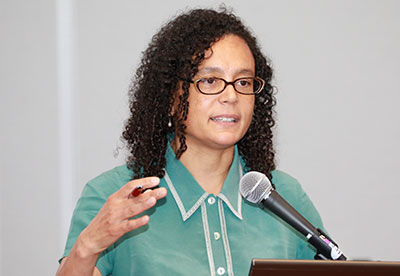From Patient to Inmate: Session Highlights Complex Interactions Between Social Policies and Mental Health Care Delivery

The objective parts of a city—the streets, the architecture—greet a visitor first. The subjective elements—the inner lives of the city’s residents—become clear only with time, said Gregory Gabrellas, M.D., a PGY-2 psychiatry resident at the University of California, Los Angeles (UCLA) School of Medicine. Gabrellas organized an Annual Meeting session on “Psychiatry in the City of Quartz: Notes on the Clinical Ethnography of Severe Mental Illness and Social Inequality.”
In the 1990 book City of Quartz, American writer and historian Mike Davis described Los Angeles as a glamourous commodity to be sold. The opposite side of that was not critical realism but a dark undercurrent that came to be known as “noir,” a world of darkness and betrayal.
Joel Braslow, M.D., Ph.D., a professor of psychiatry and behavioral sciences at UCLA and its Center for Social Medicine and Humanities, recounted one slice of that reality in a story of a homeless woman with a psychotic diagnosis. She was stopped for shoplifting. She resisted arrest, a felony. The police took her to the UCLA emergency department for medical clearance. With that, she was handed back to the police, who took her to the regional detention center for booking.
“Transforming patients into inmates is hardly unusual, a process aided by deinstitutionalization, homelessness, economic inequality, and inadequate public resources,” said Braslow. He decided to explore this case and its implications by talking to everyone involved.
The psychiatrist on duty that night told him that jail was better than the street. The woman could be housed, fed, and treated for her illness—which simply meant medication. Psychiatric drugs were the only measure of the presence or absence of treatment, said Braslow.
A hospital administrator told him they didn’t want violent patients (although this woman was not violent) or one who would need an extended length of stay, one possibly not fully covered by reimbursement.
“What we see here is an alignment of clinical practitioners with the needs of the institution rather than the patient,” said discussant Helena Hansen, M.D., Ph.D. (pictured above), an associate professor of psychiatry at New York University Langone Health.
Enrico Castillo, M.D., M.S.H.P.M., an assistant clinical professor of psychiatry and behavioral sciences at UCLA, has worked on homeless issues in both New York City and Los Angeles. The two cities have quite different approaches to care for this population, visible in their homeless statistics. In 2017, New York reported 76,501 homeless people, with only 5.1% unsheltered (for example, sleeping on the streets). The City of Quartz, in contrast, had 52,765 homeless people in 2018, but 74.6% lacked shelter.
Upstream social policies play a role in these extremely different rates of homelessness. New York state’s constitution calls for “aid, care, and support of the needy,” which the U.S. Supreme Court decided meant a “right to shelter.” That led to New York creating a system for helping at-risk, chronically homeless people find transitional and then permanent state-supported housing. Part of Castillo’s job in New York was to evaluate these individuals and write letters of support for their applications for housing, something he called “social prescribing.”
No such provision exists in California’s constitution. Worse, the state’s constitution includes a provision that prohibits construction of low-rent housing with a referendum by voters in the jurisdiction. Earlier this month, however, Los Angeles officials committed $460 million to initiatives for homeless people.
In his inquiry into the fate of the mentally ill shoplifter, Braslow found that his most sympathetic sources were the police officers.
“They had little desire to jail people with serious mental illness but felt called upon to mop up society’s other failures,” he said. “Twenty years ago, they could get a patient admitted to the hospital, but now they are discharged quickly, and it was simpler to arrest them.”
Today, they are on the streets or in jail, at least in Los Angeles.
(Image: David Hathcox)
|
|
|
|
|

